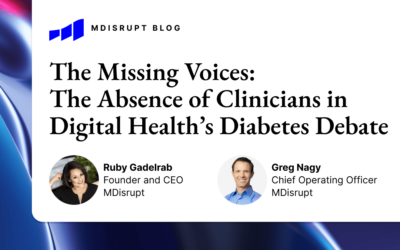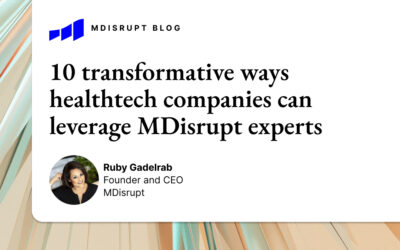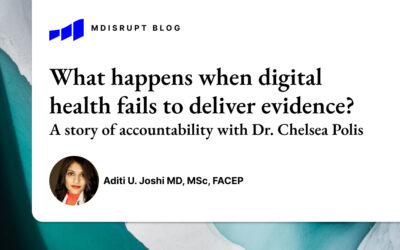
The Motley Fool recently interviewed Ruby Gadelrab, MDisrupt’s CEO and founder, about the most important 2021 trends in digital health.

Motley Fool: Why don’t we start with a brief introduction about you and MDisrupt?
Ruby Gadelrab: I have been in the biotech, healthcare, and digital health industry for about 24 years on the commercial side in various marketing and executive roles. I have worked at some notable companies in the space, including Affymetrix (now part of Thermo Fisher Scientific) and Invitae, a genetic information company. My last employed role was VP of commercial marketing at 23andMe.
Before founding MDisrupt 18 months ago, I consulted for two years for about 25 digital health companies, and I started noticing a pattern. I realized that these companies were seeking experts that understood the healthcare ecosystem. And these experts are hard to find.
MDisrupt is a platform that connects the digital health industry to the scientists and healthcare industry experts that they need to build, commercialize, and scale a health product both quickly and responsibly.
We currently work with a variety of experts including physicians, health system leaders, scientists, health economists, behavioral scientists, and lab operations and commercialization specialists.
Rapid innovation
Motley Fool: Let’s start broadly by looking at the digital health space. What were some of your most interesting observations in this space in 2020?
Ruby Gadelrab: Let’s start by defining what digital health is. Digital health is defined as the use of digital technologies and genomics to solve key problems in healthcare. So think algorithms, AI, data analytics, wearables, apps, telemedicine and virtual care, genetic tests and personalized medicine solutions. Healthcare typically has been slow to adopt digital health. Many of these solutions existed before the pandemic but struggled to get adoption.
So the high-level observations in 2020 as the pandemic hit us are these: The pandemic revealed how unprepared our healthcare system is for an event of such magnitude. The pandemic also revealed many of the inequity and access issues around health and digital health.
BUT there are silver linings. There is a fast forward button pushed on digital health and there are three themes:
- Investments – It was the highest-ever year in digital health: According to Rock Health there were $14B of investments in digital health in 2020—an increase of 72% over the previous landmark year of 2018.
- Speed of innovation – The FDA has issued over 300 emergency use authorizations for tests and devices during this pandemic. Many digital health companies quickly pivoted to create solutions for COVID-19. One example that’s particularly relevant at this stage of the pandemic is Clear Labs. They developed a fully automated platform that can screen and sequence the SARS-COVID virus in under 24 hours. Now, with the new mutant strains of the virus, this is particularly relevant for epidemiological applications in monitoring and surveillance.
- Adoption of telehealth and virtual care – This is an example of a technology that had been around for years but there was a reluctance about adoption—because of privacy issues, and because the Centers for Medicare and Medicaid Services (CMS) was only reimbursing telehealth visits in certain circumstances, for example in rural areas. But the pandemic forced patients, providers, and payors to experience different ways of delivering healthcare. In March of 2020, CMS reported that telehealth visits jumped from 10,000 per week to over 300,000.
Beyond COVID
Motley Fool: How do you expect those trends to evolve in 2021?
Ruby Gadelrab: For telehealth and virtual care, this is just the beginning. Providers and physicians experienced the comfort and convenience of delivering care from their homes. That trend will continue, especially now that CMS has released a policy showing that over 60 new telehealth services will now be reimbursed by Medicare.
Often when we think about telehealth we think of primary care services, but actually I think it will extend into areas of specialized care. One of our clients innovating in this area is Genome Medical. This is a genetics-focused medical practice that’s delivered by telehealth. They are democratizing access to the very limited number of genetics experts in the country.
For sure there will be more COVID solutions. 2020 was about getting tests and vaccines out quickly, but 2021 will be more about back-to-work solutions. For example, Mesa Biotech built a point-of-care system that does rapid PCR of COVID and provides results in about 30 minutes outside of a lab setting. This is important as we consider back-to-work solutions and ways to bring testing closer to the consumer in the workplace or in retail pharmacies, for example. They were actually acquired by ThermoFisher recently for $550M. Many of these companies are thinking about the world beyond COVID. What they can do for COVID they can potentially do for other infectious diseases, too.
There will also be increased demand for at-home testing and monitoring solutions. Throughout the pandemic, we have seen states struggle to deliver COVID-19 testing efficiently. They have faced challenges with test availability and distribution as well as long turnaround times. And as we see new surges in infection rates, these problems have worsened.
Everlywell is one of our clients at MDisrupt and is an interesting example in this category.
Their mission was to democratize and simplify the lab testing process and get high quality lab testing straight into the hands of consumers with applications such as A1c, hormone testing, etc. In May, the FDA issued an emergency use authorization, making Everlywell’s test the first stand-alone at-home sample collection kit for COVID-19 and making them the first digital health company to receive an EUA.
Everlywell has now shipped more than a million COVID-19 test kits, validating both consumer demand for at-home testing and consumer willingness to self-pay for diagnostic testing, In November Everlywell raised $175M to expand its consumer lab testing and digital health offerings and now has a valuation of $1.3 billion.
Delivering better engagement
Motley Fool: You worked at 23andMe in the past and with Everlywell during the pandemic. What’s your future vision for the genetic testing industry? Are we just now seeing the tip of the iceberg on what value can be unlocked with this kind of innovation?
Ruby Gadelrab: What companies like 23andMe and Everlywell have done is demonstrated a few things that are critically important to the future of healthcare as a service:
- That consumers and patients can effectively collect a sample at home and ship it back to the lab.
- That consumers can accurately report phenotype data.
- That a segment of the population wants direct and easy access to its health information and is willing to pay for it.
- That they can deliver engaging consumer experiences and engage consumers in conversations around their health before they get sick.
In essence, what they have built is a novel way of delivering healthcare information and patient engagement experiences. And, quite frankly, it’s a much better experience than what we can get from our healthcare system.
So I think the future of this space largely depends on who is willing to pay for this type of access, experience, and convenience. For sure there are segments of consumers who are willing to pay. But if companies like these can generate data to showcase improved outcomes, then there are potentially new stakeholders willing to consider paying for solutions like this, including employers, payors, and some health systems.
An example of this is Renown Health in northern Nevada. They launched the Healthy Nevada project where they offered patients in their system free genetic testing at home. They have had over 50,000 patients from within their system sign up and get access to their genetic test results.
Addressing health disparities
Motley Fool: The pandemic has revealed inequity in every corner of the world and revealed many health disparities. What did the pandemic teach you about the US healthcare system and what solutions might be effective?
Ruby Gadelrab: The pandemic was like putting a magnifying glass over our health system and showcasing the biggest gaps and health disparities. Everything from the most vulnerable populations contracting COVID at a higher rate to vulnerable populations suffering more severe symptoms when they contracted COVID, to who had access to testing if at all.
We saw that Black and minority populations were particularly impacted. And this started the big and tough conversations about ALL the disparities in health.
A couple of examples—most of the largest genetics databases are based on Caucasian populations. These databases are now being used to create diagnostic tests and therapeutics. Some of these innovations just won’t be as effective when you use them on minority populations. Second example—many wearables use a particular type of light to monitor heart rate. This type of light is not as accurate on people with darker skin tones. So when we think about wearables being used in a medical setting to monitor cardiac issues, these are the types of things we have to take into account.
One company innovating in this area is 54gene. They are building the world’s first biobank based on African genomes. Their goal is to close some of these gaps in health disparities by ensuring that people of African descent, globally, will be represented in the next generation of diagnostics and therapeutics.
Of course the discussion about health equity extends beyond race and into many other minority areas. Are we doing enough for women’s health? For eldercare? For the LGBTQ community? Clearly the one-size-fits-all model of healthcare isn’t working. It has to get more personalized and it has to address underserved populations by understanding their needs and their unique challenges.
One positive thing that has come from the pandemic is that there is a renewed focus on this, from investors and digital health innovators alike. We are seeing a new class of investors emerge who want to invest in minority founders building health companies that can address some of these issues.
Key steps for digital health
Motley Fool: A lot of your work with MDisrupt is advising and consulting with digital health startups. What do you tell them about competing with the big tech giants getting involved in healthcare? What competitive edges do smaller health-specific startups have over the Amazons and Microsofts of the world?
Ruby Gadelrab: Building health products that scale is really hard. And it’s hard, it’s expensive and it takes time, for everyone, whether you are a big tech company or a smaller digital health company. This is for a few reasons:
- The user, the influencer, the payor, and the consumer of health products are each different stakeholders with different incentives.
- Healthcare is highly regulated and the regulations in each country and sometimes in each state are different.
- You can’t test and iterate quickly like you can in tech. You need to do the studies to generate evidence to prove that your product is safe, effective, clinically useful, and that the economics work. These studies can often take many years.
- You have to find your earliest adopters in the healthcare world. That often involves building expensive specialized sales teams and deploying KOL programs.
- You have to get your product reimbursed and engage the medical community and medical societies.
These considerations apply to everyone, whether you are Amazon or Microsoft or smaller companies. So my advice:
Since it’s impossible for one company to solve all of healthcare, pick a specific niche area that you know really well. If you don’t know it through experience, engage healthcare experts. Ideally, hire a chief medical officer (CMO) that really knows the space and the problem you are trying to solve, and engage your target audience early and often.
Figure out early who you expect to be using the product and who is paying for it—because the type of product and commercial strategy you may build if a consumer is paying for it may be vastly different than if you expect it to be used in a healthcare setting.
Do not skimp on regulatory or evidence generation. This is an area where there are no shortcuts. The studies are critically important at every stage of commercialization. You need them to work with regulators, to convince physicians to adopt your solution, to engage medical societies and to build the dossier you need to convince payers to pay for it.
Four ways to improve outcomes
Motley Fool: We’ve seen certain healthtech companies be successful by occupying a niche where there are inefficiencies, and using technology to create value by streamlining or simplifying. What areas in the health space are still ripe for disruption?
Ruby Gadelrab: The $3.5T healthcare industry is ripe for digital disruption. Healthcare is at an inflection point. It’s changing from being transactional when you are sick, into an ongoing service designed to keep you healthy.
The health system of the past 100 years wasn’t about health or care. It’s effectively a sick care system. We need a health system that starts to take care of people before they get sick—outside the walls of a hospital and more in their daily lives, by continually engaging with consumers BEFORE they become patients.
The changes over the next few years will be driven not only by technology but also by how it’s going to get paid for. We are moving from a fee-for service system (where more procedures makes more money) to a value-based care system where health systems and providers are reimbursed by better outcomes.
So for digital health companies to be successful they need to demonstrate that they can improve outcomes. And typically these fall into one of four categories:
- Health outcomes—Can we predict and prevent disease or do a better job of managing it outside of the health system if it occurs? Medication compliance?
- Patient and physician experience—Are there solutions that improve the experience for both?
- Access—Can we simplify access to delivering healthcare for more people when they need it, either inside and outside of a healthcare system?
- Reducing costs—Can we create efficiencies in the health system or a clinical workflow that can increase productivity or reduce costs?
At MDisrupt, when we work with digital health companies we encourage them to think about which of these four problems their solution addresses, and how to generate the evidence to showcase this.
The best way for companies to do this, in my opinion, is to ensure that they engage scientists and health industry experts early and often throughout their product development. Clinicians understand the healthcare system, they see the problems and they know what the effective solutions need to be—and they can add tremendous value to digital health companies.
Connecting truth-seekers to talent
Motley Fool: Let’s talk about the medical diligence part of MDisrupt. Diligence is important for investors in any sector, but in healthcare, the stakes can be life and death. Of course, investors can only base their decisions on information the company makes available, and we’ve seen instances of management either withholding certain material info or even outright lying at what its technology is capable of. What have you learned about medical diligence and how can investors have more confidence in a company by harnessing this knowledge?
Ruby Gadelrab: This was a really interesting experience for us when we first founded MDisrupt. Investors weren’t really our first customers.
What we found early on is a breed of digital health companies where the founders were truth seekers and determined to create impactful, responsible health products and get them to market quickly. Many of these founders had business or tech backgrounds. They understood that access to health industry expertise was critical to their success and yet that talent is relatively hard to find. They were asking us for chief medical officers, regulatory experts, health economists, lab scientists, product managers and behavioral scientists.
At the same time, we were inundated with hundreds of messages from scientists, clinicians and other health industry experts asking us how they could get involved in lending their expertise and knowledge to digital health companies. We quickly realized we needed to build a platform that could connect digital health companies to the experts.
I guess like other start-ups in this space, finding true product-market fit is when the market pulls you in a specific direction. So that’s where we focus now, on helping the digital health companies connect to the experts so they can get to market quickly and responsibly.
Of course, if investors want access to our experts to help them diligence their investments for clinical and commercial viability, we are more than happy to help them too.
Motley Fool: The pandemic has revealed inequity in every corner of the world and revealed many health disparities. What did the pandemic teach you about the US healthcare system and what solutions might be effective?
Ruby Gadelrab: Here are the top trends we see at MDisrupt:
- Telemedicine and virtual care
- New Covid solutions focused on getting back to work
- At-home testing and monitoring solutions
- Behavioral and mental health solutions
- Femtech
- Teams which have a good balance of tech and healthcare folks.
At MDisrupt we believe that the most impactful health products should make it to market quickly. We help make this happen by connecting digital health innovators to the healthcare industry experts and scientists they need to responsibly accelerate product development, commercialization, adoption, and scale.
Our expert consultants span the healthcare continuum and can assist with all stages of health product development: This includes regulatory, clinical studies and evidence generation, payor strategies, commercialization, and channel strategies. If you are building a health product, talk to us.



